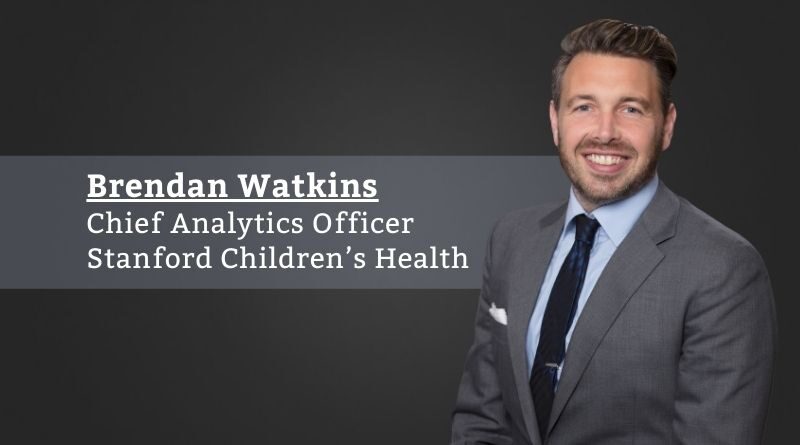Deploying Technologies to Enable Federated Analytics
By Brendan Watkins, Chief Analytics Officer, Stanford Children’s Health
Tips:
1) Leverage the excitement of data exploration and visualization technology rollout.
2) Don’t let the technology overshadow the structure.
3) Choose the people in the analyst layer well; they provide important insights across the organization.
The success of a company relies on people making right decisions. Right decisions rely on the wisdom should be gleaned from information that, in turn, is derived from the systems that reflect what is happening within the organization. For us at Stanford Children’s Health, this could involve understanding of our patients and families’ experience or monitoring of the services we offer or helping our practitioners with relevant clinical information. In all cases, people all over the organization need insights, and a highly functioning organization will ensure these decision-makers can make data-driven decisions. Vital to this capability is the deployment of federated analytics in addition to a strong central team and the technology to support this function.
Federated analytics is the enablement of selecting people in the organization who perform deeper analysis than most other employees. In some cases, it may be full teams that support a segment of the enterprise, such as Strategy, Finance, and Quality, or it may be one or two analysts supporting a specific department. These Analytics Power Users are given the tools and training required to support the organization with insights broadly spread across groups to ensure there are no data gaps.
If data is the new oil,this oil should course through the organization’s machinery to provide the insights needed to make it run smoothly. The federated analytics layer should provide knowledge to management in decision making and clinical or process improvement efforts. It is crucial to have this layer of the organization on the same page and provide correct and insightful information to itsstakeholders.
Technology enables this important layer to function well. Collaboration tools should enable communication and alignment among the analysts that may be geographically and functionally dispersed. Communication and content sharing across many analysts’ permutations are crucial for partnerships in overlapping areas or simply enabling the community to learn from each other. Meta-data management tools are also essential to keep everyone on the same page. These tools should enable a data governance framework that documents what metrics and data elements mean, so there are consistent generation and sharing of insights.
Regardless of the tool, the technology allows for curating data sources that can hide the typical complexity of database management and provide the perfect playground for folks who love to analyze data and prefer to be closer to the business than purely technical. Taking the time to develop curated data sources that provide sufficient depth of understanding requires a partnership between data architects and business analysts and is well worth it.
The most important technology is one that allows the analysts within a Federated Analytics environment to access, explore, and visualize data from curated sources. These technologies can hide the typical complexity of database management and provide the perfect playground for folks who love to analyze data yet remain close to business operations. Vendors like Tableau, Qlik, and SAP all provide tools that are both accessible and powerful in data exploration; the key is to put in the work to develop accessible and powerful data sources.
At Stanford Children’s Health, we adopted a ‘virtuous cycle’ approach, whereby we have successes in one element of the Analytics strategy feed the other aspects. We develop strategic analytics solutions that call for defining metrics and building curated data sources as the foundation. Development of these solutions often involve partnerships with many analysts within the Federated Analytics community, and so they share in the development of the sources that they will use for deeper analyses.
Typically, the analysts who populate the important analytics layer in the organization will be excited to embrace new tools to better understand their areas of business. This presents a great opportunity to corral this talented group and work to align their efforts. Be deliberate about using the opportunity to make a splash with the rollout of new technology. It is vital to have visibility at the executive governance level to showcase the talent that exists at the analyst layer and extol the virtues of harnessing this talent through support and alignment.
On the other hand, be careful to ensure the rollout is not all about the technology. With the sophisticated tools to analyze and explore data that are also much more user-friendly than before, there will be challenges as individuals may inadvertently cut corners or misinterpret data and come to incorrect conclusions. The tools are powerful in talented analysts’ hands, but these tools won’t make the alignment happen. Structure, process, communication, and the tools to support them are crucial to harnessing the talent.
Carefully consider who to include in the analyst layer. There may be folks who are ravenousconsumers of data but misidentify as technically sophisticated or have enough bandwidth to operate in the federated analytics layer. This will dilute the group and hinder alignment and support for the others. There will inevitably be varying strengths across the analyst layer, but this should be expected and planned accordingly. It may be helpful to provide platinum support for the very active analysts. This sub-group will be excited about new ways to understand their business, and this excitement should be harnessed for the benefit of the analytics and the organization.
The technologies to support federated analytics are more sophisticated and accessible than ever before. These should be deployed as part of a vision to harness the talent in the organization’s insight-generating layer. Alignment is key and often not easy. Technologies should support the structure, but there will be hard work to develop the foundational sources and keep everyone aligned. The good news is that it is immensely powerful when insights and information are seamlessly provided throughout the organization to help make right decisions.



